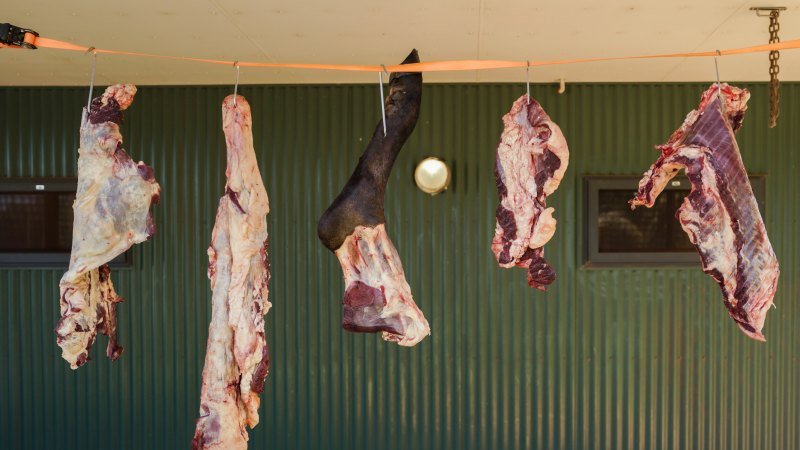A time-worn tradition that puts meat on the plates of many Aboriginal families in WA’s north is the focus of a Perth Festival installation.
A time-worn tradition that puts meat on the plates of many Aboriginal families in WA’s north is the focus of a Perth Festival installation.
By Victoria Laurie
February 4, 2025 — 2.00am
A Kimberley bullock running through pindan country is chased down, killed and butchered, in a time-worn tradition that puts meat on the plates of many Aboriginal families in Western Australia’s north.
“I’ve been doing it since I was a little kid growing up in Broome,” says Chad Creighton, chief executive of the peak body for Indigenous art centres AACHWA and an independent artist.

“Twenty years ago, I did a project where I covered a turtle hunt and (the process of) eating it. People back in Perth couldn’t believe that we hunted turtles, so I showed screens of the hunt and the packs of frozen turtle meat.”
In a new cattle version of bush hunting, an installation-cum-feast titled Killa: Pindan to Plate has been created by Creighton and his co-curator Emilia Galatis for Perth Festival, which opens on Friday.
The pair recently filmed a bullock hunt in Karajarri country near Bidyadanga with a team of experienced Aboriginal cattlemen, documenting the chase, the kill and carving up of meat portions that were stacked in the back of a troop carrier, frozen and then cooked in various ways in communities on the Dampier peninsula, 200 kilometres north of Broome.
“This is what the ringers involved do regularly to feed their families, and we gave a lot of the meat away to families who had a funeral coming soon,” says Creighton.
“Meat is very expensive so it’s shared to alleviate financial pressure.”
The Killa dinner, to be served up over six nights only of the festival, is a “nose to tail” culinary event in which diners are surrounded by the vivid video installation on all sides showing how slain Kimberley cattle, called “killa”, ends up as a staple for Aboriginal people.
Intended as both a cultural and culinary experience, Killa guests are simultaneously served chef-cooked gourmet treats revolving around locally sourced beef and Kimberley seafood.
“We want people to have fun in a bush dining experience within a fine dining experience,” says Galatis.
“We worked closely with the chef to make sure there’s smoke and bush scents so that it’s an evocative experience.
“We thought Killa would be fun to do, shining a light on everyday practices that Chad grew up with, and that I experienced in my 20s and 30s living on country in the Kimberley. You know where the animal has grazed, what it’s eaten. We’ve worked the threads of that story into a fine dining setting.
“I saw Killa as a new way to view the Australian food narrative,” she adds.
“I’m third-generation Greek and our culture communicates through food. The migrant food history has slotted into the broader Australian narrative in a way that Indigenous food hasn’t.”
She says there are global messages about thoughtful consumption, like the Kimberley hunting tradition that involves “giving reverence to an animal that’s lived its life for you to consume.”
“People think that seeing the insides of an animal is grotesque, but I think pumping farmed meat with antibiotics and hormones is grotesque.”
“Art is such a powerful tool to help people understand,” says Creighton.
“We thought immersing people in an enclosed space means there’s no getting away from the images.”
Killa explores the pragmatic side of having a readily available fresh meat supply, given the high cost of foodstuffs trucked into Western Australia’s remotest communities.
“It’s food that’s sat in a truck for three or four days, and a warehouse,” says Galatis.

“A lettuce is $11 in the Western Desert, and it’s already going off on the shelf. Plant-based food in these settings is completely unaffordable when you’re feeding a family of three or four. You may not have a fridge to keep fresh foods, or there’s been a power cut.”
Filming the cattle chase in 40-degree heat was eventful, as a giant chest freezer towed out into the bush didn’t work.
“We had to go back to old school method, pile meat in the back of the ute and drive as fast as we could back to camp,” says Galatis.

“Usually the ringers move very quick, because of the importance of getting out of there safely. The bush butchering they do is a magnificent art form, knowing how to cut and using knives and no machinery. And they use all the animal, not the 10 per cent we eat as steak and chops.”
The Kimberley was opened up in the late 1880s in a colonial push by white pastoralists like the Durack family, who occupied its vast grasslands and co-opted Aboriginal station hands into unpaid labour.
But Creighton wants Killa to celebrate the Indigenous side of Kimberley cattle country. Every ringer, every pastoral community has a story, he says.
“There’s a hundred stories that could be told as variations on this project. And the employment opportunities that cattle stations offer really suit people who don’t want to work and live in town.”
He says he was struck by the teamwork of the Karajarri and Bardi men captured on video – Bolo Angus, Lloyd Pigram, Scott Cox, Jeffrey Parriman, Terrence Creighton, Phillip Sibosado and Justin King senior working alongside his son, Justin junior.
“The camaraderie and laughter is phenomenal, they are cracking jokes all the time,” says Creighton.
“I realised this lifestyle is good for men’s mental health. At the end we all had a big group hug!”
KILLA: Pindan to Plate opens Friday, February 14, and runs until February 23 at Rechabite Hall from 6.30pm.
Start the day with a summary of the day’s most important and interesting stories, analysis and insights. Sign up for our Morning Edition newsletter.
Victoria Laurie is a senior reporter and feature writer who has written for Good Weekend, The Australian, The Bulletin, The Monthly, HQ, Australian Geographic and The Weekend Australian Magazine.
Discover more from World Byte News
Subscribe to get the latest posts sent to your email.



